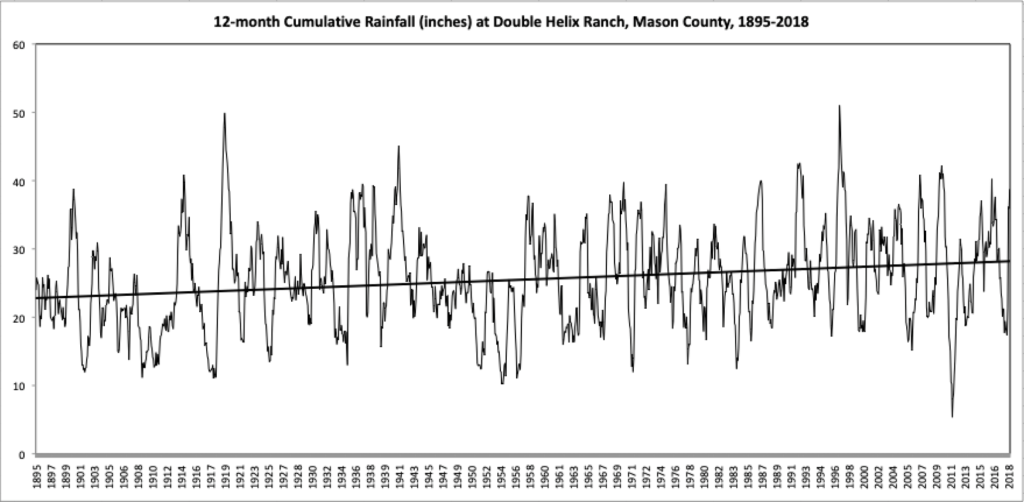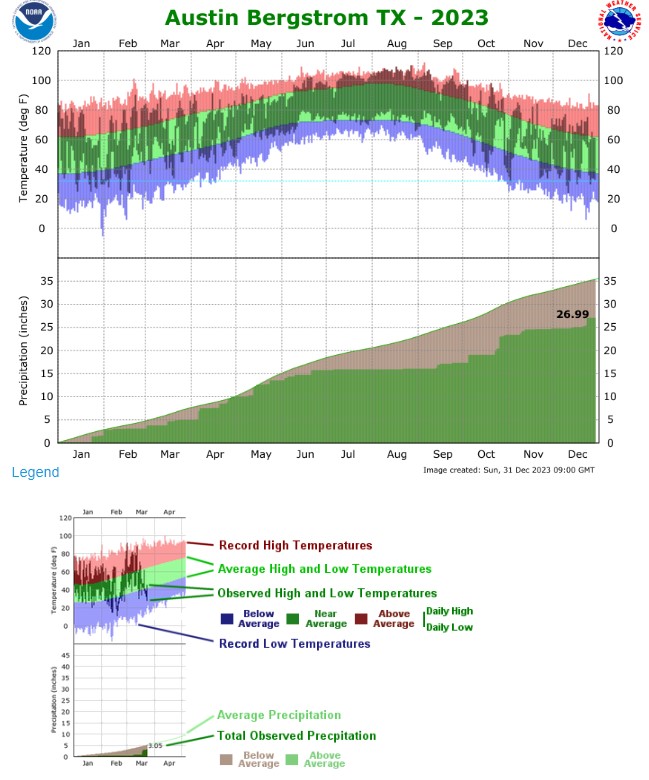It doesn’t matter if you are a newcomer or an oldtimer, the weather here in the Austin area is very hard to predict and garden with. The winters are fairly mild punctuated with the occasional multi-day freezes, and the summers are fairly brutal punctuated by torrential thunder storms. As a result, checking the weather and being prepared should be at the top of your gardening to-do list. Depending on the time of year, you’ll need to deploy several weather strategies to be successful at gardening.
No Such Thing As Normal Rainfall in Texas
Central Texas is at the confluence of three major weather influences: the jet stream, the Gulf of Mexico, and the polar vortex. The interaction produces a lot of variability in temperature and rain patterns. The University of Texas has been tracking rainfall at the Double Helix Ranch in Mason County Texas since 1895. The data shows that there really isn’t anything that can point to a normal pattern.

No Such Thing as Average Temperature in Austin
Perhaps not surprisingly, temperature follows the same sort of swings. The National Weather Service publishes climate graphs depicting local temperatures and rainfall by year. The graph below depicts the High, Low, and Average temperatures at Austin Bergstrom Airport in 2023.

Central Texas Almanac
As of 2023, the following data can help inform your gardening calendar.
- Rainfall averages 36.25 inches per year with a range of 11.42-65.31 inches
- Average number of days without frost or freezes: 270
- Last spring freeze average is February 25, latest on record: April 9
- Average first fall freeze is November 29, earliest on record: October 26
- USDA Hardiness Zone 9a where the average lowest temperature is 20 to 25 degrees
- American Horticultural Society (AHS) Plant Heat Zone 9 where the number of days per year temperature is above 86 degrees ranges from 120 to 150
Weather Strategies
So what is a gardener to do? The best strategy is to remain flexible. No matter what the weather is doing, it’s likely that it will change soon. Here is a list of our top tips:
Use microclimates
The prevailing winter winds come from the northwest. Use plants that can handle (or even require) the cold and use windbreaks (like your house) to protect tender plants. In summer, the wind shifts to the southeast and brings hot, humid air from the Gulf of Mexico as a result of the Bermuda High Pressure System.
Monitor Soil Moisture
Most people think of irrigating plants in the summer. But due to winter weather patterns, December through the first of March can be quite dry in the Austin area. This makes plants especially susceptible to freeze damage. Monitor soil moisture to make sure plants can draw the water they need into roots, even when it seems they are dormant. Air spaces left in the soil can freeze roots under certain conditions. The TexasET Network can help you understand irrigation requirements based on weather information and average evapotranspiration data.
Prepare for Run-off
When it rains, it literally pours. Most rainfall arrives through thunderstorm activity. These short storms can provide inches of rain in less than an hour. No soil has the capacity to absorb that kind of flow, so be prepared to handle run-off. Berms and swales can direct and hold water long enough to soak into soil and prevent some flooding. Property owners near green belts and creeks should monitor for fallen brush that creates temporary dams. Avoid having any bare soil that can easily wash away. Use mulches and temporary barriers while cultivating new garden areas.
Plan for Water Restrictions
Due to the weather patterns, Texas is vulnerable to drought, which is exacerbated by population growth. Most people in Central Texas get their water through the Lower Colorado River Authority (LCRA). LCRA has predicted that Austin will need additional water supplies by 2050, whether or not there is a drought during that period. After the last drought period, the city of Austin and many other municipalities have kept water restrictions in place as a precaution and way to educate the public about water use.
Homeowners should make long term plans for landscape water conservation. This includes the following:
- Plant drought tolerant plants. Use native and adapted plants from the GrowGreen plant database. The best time to plant is during the fall, winter, or very early spring.
- Utilize trees. Shade trees cool the landscape and lower the evapotranspiration rate. Evapotranspiration is the loss of water from the soil due to transpiration. Plant trees on the western side of your landscape to receive the most benefit from shade.
- Install drip irrigation. Many existing systems can be converted to drip irrigation. Drip is 90% efficient compared to spray because it delivers water right to the plant. In some cases, drip irrigation is exempt from drought restrictions.
- Aerate your lawn. Clay soils tend to become compacted over time, which reduces the soil’s ability to absorb water. Proper aeration actually removes plugs from the soil, as opposed to just poking holes in the ground. Add about 1/4 ” to 1″ of compost to the area after aeration to deliver compost right to the roots.
- Update your automatic sprinkler system nozzles and controllers. You want multi-stream spray heads and a controller with water conserving settings like cycle and soak.
Two Short Growing Seasons
Thanks to summer heat, there are actually two short growing seasons in the Austin area. Many annuals, including vegetables, wither once nighttime temperatures exceed 76° F. In some plants, including tomatoes, the pollen becomes sterile to prevent the plant from setting fruit. Heat is also a trigger for plants to produce seed and go into dormancy. No amount of water can stop this cycle, so it’s important to conserve water resources for plants that are not impacted.
Plant Natives
Native plants are adapted to the temperature swings and soil conditions, so utilizing these plants generally provides more chance for success. However, just because it’s labeled as a native doesn’t mean it’s actually native to Central Texas. Texas is a huge state with many different growing conditions. Do your research ahead of time so that you choose appropriate plants. The best resource for Austin is the Native and Adapted Landscape Plants guide. It’s available as a pdf, a searchable database, and a free brochure that many local nurseries have on hand. The information is a joint project with Texas A&M AgriLife extension and the city of Austin’s Watershed Protection Department. There are other FAQ sheets and landscape templates available on the GrowGreen website.
Additional Resources
- CoCoRaHS – Community Collaborative Rain, Hail & Snow Network. Volunteers report their local rainfall conditions. Members receive weather summaries for their area
- USDA Hardiness Zone Map. This map is the standard by which gardeners and growers can determine which plants are most likely to thrive at a location. It’s based on the average annual minimum winter temperature, divided into 10-degree F zones and further divided into 5-degree F half-zones. This map was updated in 2023 based on averages through 2020. Read more about how the map is created.
- USDA Climate Hubs. Provides tools and information by region for the agricultural industry. Hosted by the Agricultural Research Service and Forest Service located at ten regional locations, with contributions from many agencies and universities.
- Future Cold Hardiness Zones model. Input your zip code to see how climate models forecast changes in the USDA Hardiness Zones.
- U.S. Drought Monitor.
- World Microclimates. Austin is classified as Cfa – Humid Subtropical Climate.
- Lower Colorado River Authority (LCRA) Lake Levels.
- Climate Graph for Austin-Bergstrom TX
- Drought Resources from Texas A&M AgriLife Extension
- Texas Commission on Environmental Quality (TCEQ) Drought Response
- Frosts and Freezes
- Plant Problems and Maintenance
- Fruit Tree Chill Hour Requirements
- Native and Adapted Landscape Plants searchable database
- City of Austin Watershed Protection GrowGreen Program
